STREAMLINING PASTA
I wholeheartedly thank everyone for their warm regards for Bado. She’d be ecstatic if she knew how much attention she could single handedly bring in. I’ve always knew that she beats buttered biscuits.
…I’m thinking, grief in its pure form is quite harmless, to be handled as a cold that wants nothing more than to run its natural course. Crying in the shower… sniffing her toys, whatever, sooner or later it always does. But unfortunately it’s now mixed with a toxic dose of regrets, guilt and self-blame and becomes a gust of acid rain, dampening every opening of a smile and making the lightest garment feel heavy… and sploosh!, melts me to the ground with it without warning. The cold fact that we’ve failed our baby girl, and the meaninglessness of how all our hearts and efforts meant the opposite, really…, really. Hurts.
I’m sure it all makes no sense what I’m saying… To shut my brain up and spare us both, I started making some pasta that night.
Instead of a recipe, I’ve been wanting to test a technique of rolling out pasta sheets, and there was no better time to do it than 2 days ago when I rather do anything but think. I saw it at a glimpse during an episode of Iron Chef America, and thought it was genius. I don’t know about anyone else, but on top of many other sweating labours that come with homemaking pasta, I loath the most about the part where I have to re-feed, and re-feed, and re-feed the pasta sheets again, and again, and again through every single narrowing increments until reaching my desired thickness. Repetition in tasks (… or mistakes) is a bore.
So here’s the trick. Instead of letting the pasta sheet completely pass through the machine at the first/widest setting, you pick up the 2 ends of the pasta sheet when it’s only halfway through. You overlap and pinch them together. You run it through the machine so they stick soundly. And then, you have a never-ending conveyor belt of pasta sheet that will keep rolling without the need of re-feeding at every change of setting, plus no awkwardly shaped ends to be wasted (I would normally put !!! here but my anti-grief medication is making me quite indifferent).
So I tried it, that night, and it carried out marvellously just as my indisputable sadness. The pasta sheet ran smoothly without interruption or drama, through every narrowing increment and time, stretching and thinning itself out until eventually as thin as fabric that light can finally seep through. Discreet and untheatrical.
If I’m not taking about rolling out pasta dough anymore, then maybe there’s a trick to be learnt in both.
Makes: enough pasta for 4 people
I have a general rule of thumb when it comes to the ratio of pasta doughs. Whenever I’m going for a chubbier, softer and chewier pasta such as orchiette or tonnarelli, I would use a higher ratio of semolina flour in the dry ingredients, and eliminate egg whites from the wet ingredients. And vice versa. The egg whites make the pasta dough firmer with more of a “bite” which is great if you are making something delicate and fragile like thin sheets for ravioli, or thin noodles like trenette or tagliatelle. But it would make the dough way too tough to chew if you are making something very chubby and thick like orchiette, or thick noodles like tonnarelli.
Dough for thicker/chewier pasta such as tonnarelli or fresh spaghetti:
- 5.3 oz (150 grams) of Italian tipo 00 flour
- 5.3 oz (150 grams) of semolina flour
- 1/2 tsp of fine salt
- 3 large free-range egg yolks
- 2 ~ 3 tbsp of water
Dough for thinner/firmer pasta such as ravioli, trenette or tagliatelle:
- 7 oz (200 grams) of Italian tipo 00 flour
- 3.5 oz (100 grams) of semolina flour
- 1/2 tsp of fine salt
- 3 large free-range eggs
To make the dough: Place all the flours and salt inside a large bowl and make a well in the center. Add the large egg yolks (or whole eggs) into the center of the well and whisk them with a fork. Slowly work your way outwards to gradually incorporate the flour into the eggs. If you are making a dough for thicker/chewier pasta, add 2 ~ 3 tbsp of water to bring the rest of the flour together. Now slowly knead the dough inside the bowl and try to get all the flours into the dough. If the dough feel too dry to come together, wet your hands with water and work the water into the dough (instead of pouring water directly onto the dough) because it gives you better control as how much more water you are adding. Once the dough as come together, take it out of the bowl and start kneading on the counter. You must do this vigorously for about 10 minutes, until the dough is very smooth and elastic. It should spring back when you make a dent with your finger.
Wrap the dough in plastic wrap and let rest for at least 30 min.
To roll out the dough: Dust the counter with semolina flour and place the dough on top. Cut the dough in half and cover 1 piece under plastic wrap.
With the other piece of dough, dust lightly with semolina flour and press it down into a flat oval shape with your hands. With a counter-top pasta machine, or a pasta machine-attachment on your mixer, run the dough through the widest setting. Then fold the dough in 3 folds (like folding a letter), and run it again. Repeat once more.
Now you should have a rectangular/oval-shaped dough with sort of uneven ends. Don’t worry about it. Feed the dough through the machine again, but this time, STOP MIDWAY. Then bring the 2 ends of the dough together, overlap them and pinch them lightly so they stick. Hold them in position and start running it again through the machine. Once the “seam” passes through the machine, you should have a connected, “conveyor belt” looking pasta sheet that passes through the machine. Keep running the machine to ensure that the seam/connection point is tightly merged together.
Now, no more re-feeding.
All you have to do now is setting the machine to the next increment, and keep the pasta sheet rolling through it (like a conveyor belt!). Make sure to dust generously with flour on top AND underneath, and that the entire length of the pasta sheet has passed through each increment before moving onto the next.
Roll the pasta sheet out to your desired thickness, then sever it midway. Roll the pasta sheet out of the machine to release it. And cut into desired shape.
Repeat with the other half of the pasta dough.



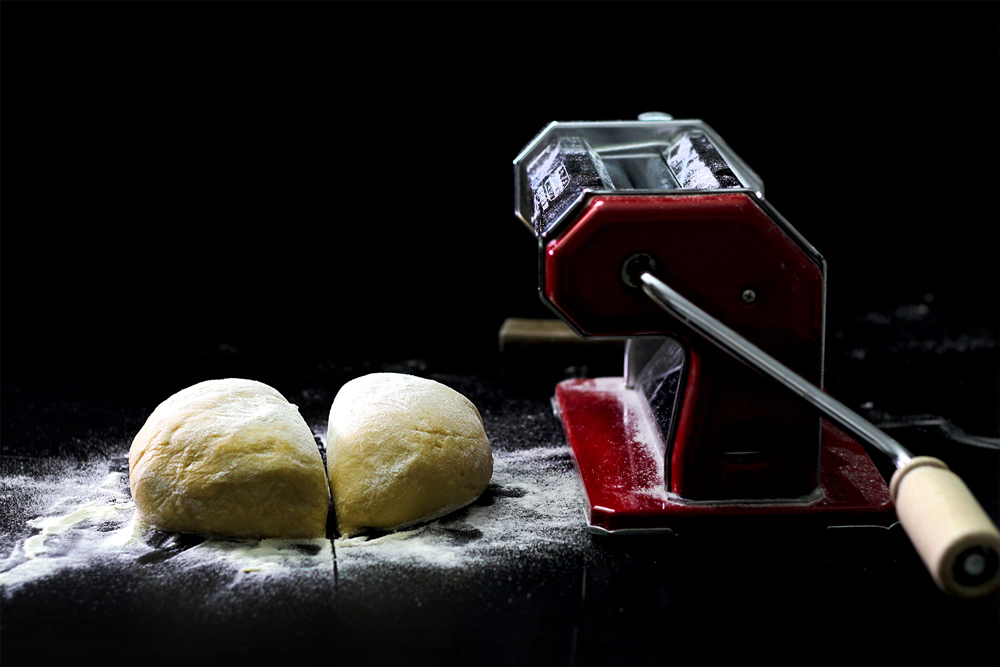
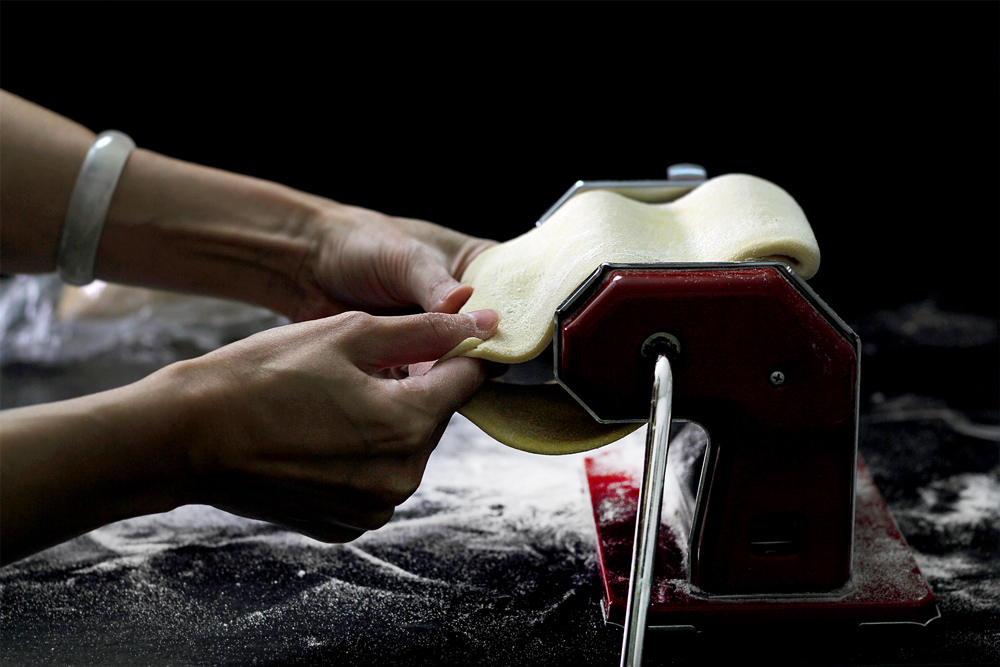
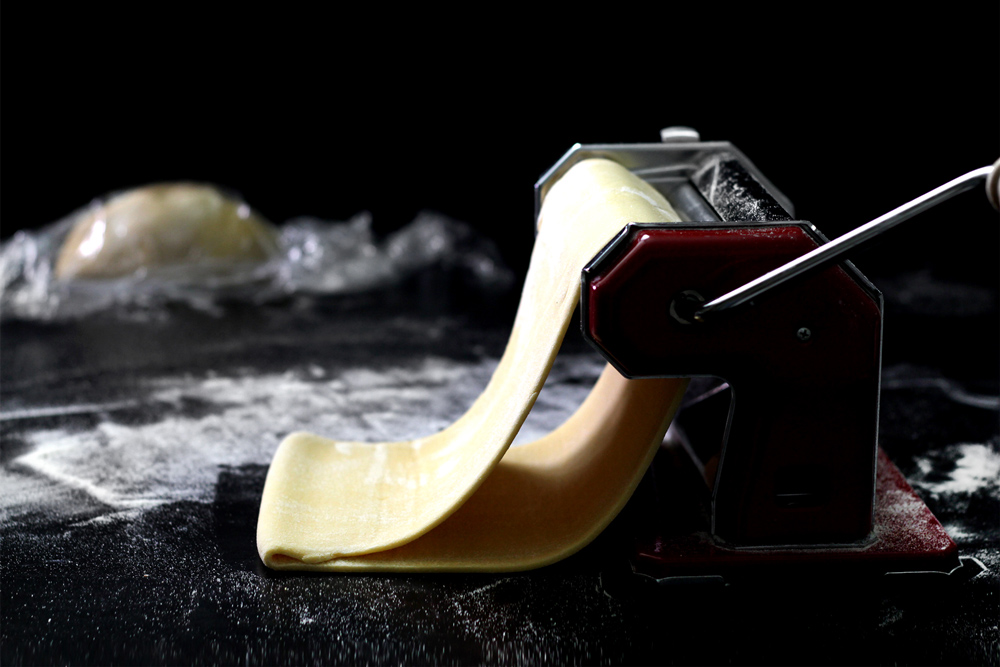
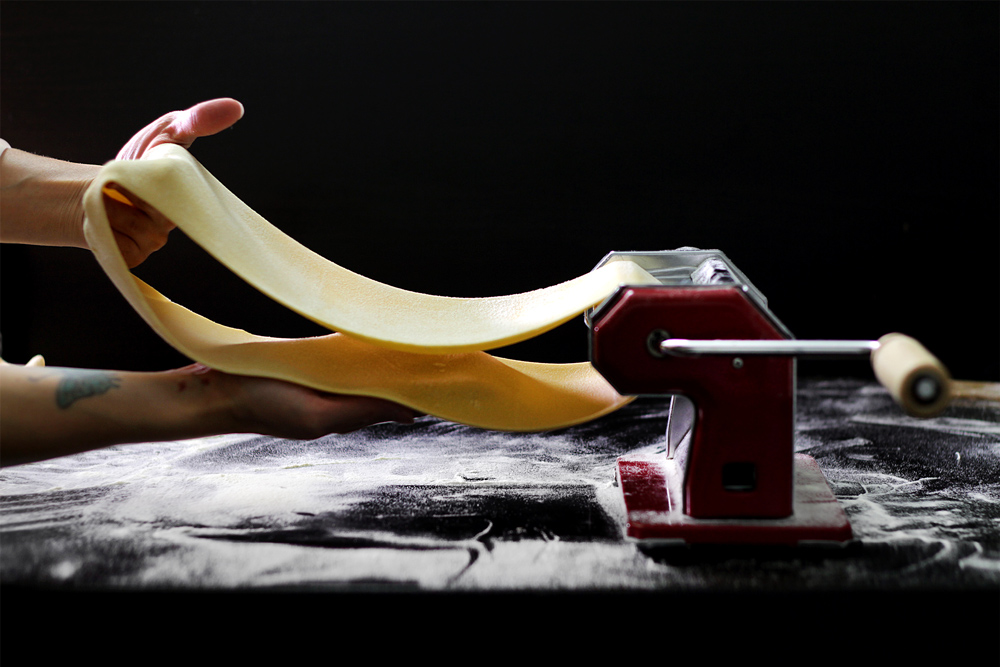

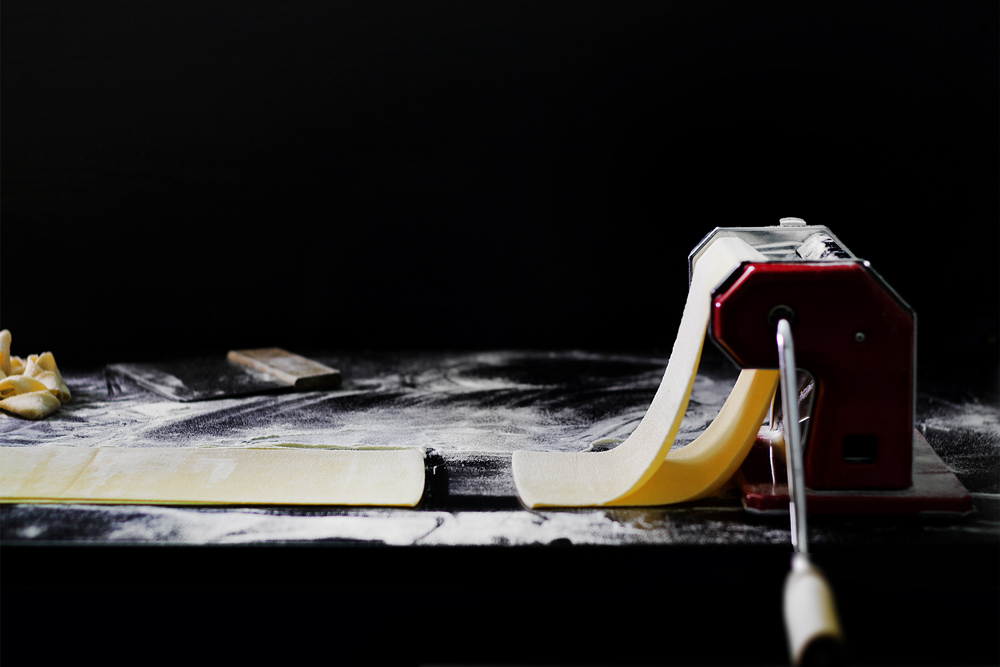

Belinda @themoonblushbaker
10.24.2013at3:58 PMI am glad you can still blog, I would be in a mess. SO often the emotions mix in the food right? This looks gorgeous mandy! I am in love with the pasta technique and you documented it so well.
Mandy L.
10.24.2013at5:19 PMBelinda, well I’m trying my best :) At least blogging doesn’t require stepping out the door… my face might scare ppl at this point.
Roberta @ fish chips & gelato
10.24.2013at6:28 PMWe lost our dear old Bingo, the wisest and scruffiest dog I have ever known, exactly a year ago. I think the sense of loss will never disappear: the bouts of pain have slowly given way to something else. Now, there is a little Bingo-shaped hole in everything I do and think, and however strange this might sounds, it makes me feel warm and happy.
I hope you will be able to forgive yourself – I am sure Bado would have.
Mandy L.
10.24.2013at6:35 PMRoberta, oh I’m so sorry to hear that… I just hope that Bado knew that everything we did was trying to give her more time…even if it wasn’t enough. Give a little kiss to Bingo’s picture for me :)
Sophie
10.25.2013at12:27 AMBado absolutely knows you did everything you could! I am sure in no way did you fail her. You loved her, every second.
I can hardly believe you’re still blogging, either… as I would feel too numb to move, I imagine. I hope you’re finding it therapeutic. Cooking, at least, always is.
This is such a revalation. A pasta conveyor-belt! GENIUS, and thank you for sharing your tip. As I am making ravioli next week, I appreciate also your advise on adding the egg whites as well. You’re incredibly good at this whole cooking thing. Can’t wait to try a new way to roll.
Mandy L.
10.25.2013at12:35 AMSophie, that’s so kind of you, thank you. I just have to power through my sadness. And yes, cooking is quite therapeutic in a way that it keeps me busy (or stops me thinking…). Otherwise I go flipping through bado’s old photos and that’s just not helping.. :P
This trick really works so much better than re-feeding the sheet back to the machine every time! And once you cut it loose, there’s no awkward shaped edges, which is VERY CONVENIENT for ravioli-making if I may say.
Sophie
11.09.2013at12:50 AMYou were right, of course — this is a fantastic way to roll pasta sheets! Each one was wide enough for my ravioli press, and no fussy weird ends. My best ravioli to-date (kabocha squash, thyme, Parmesan and garlic filling)…. so thankful for your expert advice!
Sofia
10.25.2013at3:22 AMIt cannot be possible that you failed Bado, when I am sure she recieved so much love. But I know how you feel, when my family pets have died,… buf… xx
afracooking
11.30.2013at3:59 AMA warm hug – from a total stranger, but with real feeling!
Mandy L.
11.30.2013at3:40 PMAfracooking, thank you so much. Hugging back…